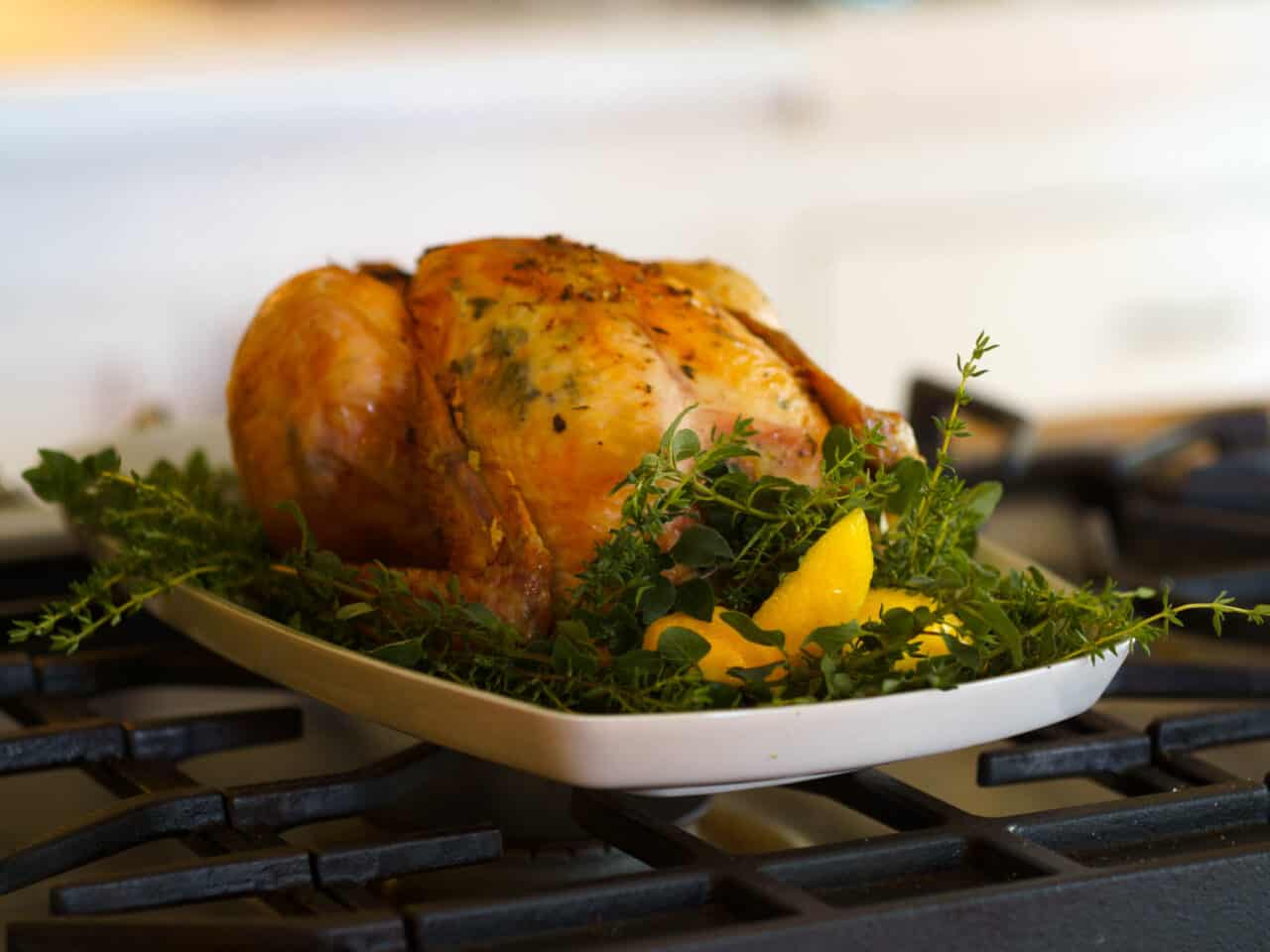A rotisserie chicken is a modern convenience food. It’s ready for you to eat (and even still hot at the store!), can be served as a traditional carved bird, or it can be shredded to use in other dishes – and it’s cheap! Take a little hands-on time, though, and a long, slow cook in the oven, and instead have your own tender and tasty chicken that’s locally and humanely raised.
Is that rotisserie chicken really inexpensive? Although it will depend on the store and day, usually no. There are loss leaders or fresh chickens nearing their sell-by date that a store decides to use, but, generally, the rotisserie chickens are just smaller than the fresh chickens you will buy in the same store.
What about the convenience? If you’ve made a special trip to pick one up, you’ve spent more time than prepping a roast chicken takes. Certainly they look and smell appealing when you’re already shopping and hungry, but a little planning ahead can mean that the chicken is already prepared for you at home.
How was that bird raised? A chicken purchased at the grocery store is definitely going to be factory-farmed. Even if you shop at Whole Foods it may not be raised the way you might think. You probably have seen information about the 5-stepanimal welfare rating. Looking at the Global Animal Partnership site shows that a chicken has to be at least step 4, and more likely step 5 or 5+ to compare what you’d get at market. Step 1 is barely one step up from the lowest level of care. Right now at the Chattanooga Whole Foods a rotisserie chicken is Step 2 and on sale for $7.99. You get what you pay for: Step 2 provides little improvement: enrichment activities and no cages but a life all indoors.
What is a busy locavore to do? Make your own! There are many ways to roast chicken that take different amounts of prep and cooking time. The October issue of Real Simple has a recipe for chicken with 10 minutes of prep, then 2 ½ – 3 hours on low heat to roast without any attention needed. The long time does make this likely a weekend project. If you’ve purchased your chicken frozen, great, leave it in the fridge till the weekend and it will hopefully be defrosted and ready to go. (I feel like chicken takes forever to defrost so I’m a little cynical about how long it takes.) If you’ve bought it fresh on Wednesday, will it still be good Saturday or Sunday?
I went down a reddit hole trying to figure out safe poultry shelf life via the internet. I’ve waited until the weekend to cook Wednesday’s fresh chicken myself, but I wanted to make sure it was safe enough to recommend! The USDA’s official recommendation is to cook your fresh poultry 1-2 days after you get it home. This is a recommendation intended for poultry purchased in a supermarket or similar store. I wondered, though: how long does it take for a fresh chicken to get from slaughter to store? How long does it sit there before you buy it? Vegetables and fruits can be days or weeks old, eggs can be months old, surely chicken suffers a similar fate?
Yet, it turns out, you don’t want to eat your chicken too fresh! You can eat it within a half hour of slaughtering but wait much longer than that and you need to let it rest for at least 24 hours. Some sources say 4 or more days for best flavor. I find this fascinating! According to an NC State poultry professor, chicken can reach the store a day after slaughter, but should be consumed within 14 days at the latest. Two weeks is a long time. But note: chicken needs to be keep at 40 F or below during that time. Please be safe and bring a cooler or insulated bag plus ice packs to market if you’re going to hold your chicken over.
Not only is your chicken going to be local but some of your seasonings will be as well. Rosemary and thyme or oregano are sturdy herbs that can stand up to long cooking. They’re readily available at the market, and thyme and rosemary grow well unprotected through the winter. Salt, pepper, and lemon round out the seasonings for a tasty chicken that goes well with many dishes that is able to stand alone as well. Lemon thyme could be used as a substitute for the lemon zest. The lemon itself adds moisture to the chicken but with long and slow cooking it shouldn’t matter too much. I’m going to try lemon thyme with this week’s chicken.

Real Simple’s recipe doesn’t mention this, but I learned from Martha Stewart to loosen the skin on the breast and rub it with fat and seasonings directly on the meat as well as on the skin. She also puts thin rounds of goat cheese under the skin and arranges sage leaves (sage is another good herb for roasting) nicely on top. It’s pretty but not necessary for a yummy bird.
For your side, roasted veggies are a natural match. Usually I roast at high heat, but roasting veggies alongside chicken or other meat is pretty traditional. Real Simple recommends a separate pan of veggies; you decide which you would prefer. And if you roast plenty of vegetables you will have the beginnings of plenty of meals for the following days.
Slow-Roasted Lemon and Herb Chicken
From Real Simple Magazine October 2017
Ingredients:
1 tablespoon kosher salt
2 teaspoons chopped fresh rosemary
2 teaspoons chopped fresh oregano or thyme
1 lemon, zested
½ teaspoon freshly ground black pepper
1 3½ -to 4-lb. chicken
1 tablespoon olive oil
How to make it:
Step 1
Preheat oven to 300°F. Combine salt, rosemary, oregano, 1½ teaspoons lemon zest, and pepper in a small bowl. Place chicken on a rimmed baking sheet and rub all over with oil. Season with herb mixture, inside and out. Halve lemon and place inside cavity.
Step 2
Roast until chicken is pull-apart tender (grab a leg and wiggle it; it should easily come away from the bird), 2½ to 3 hours.
Printable recipe here





0 Comments